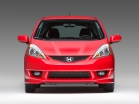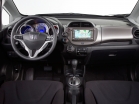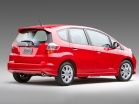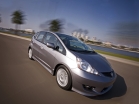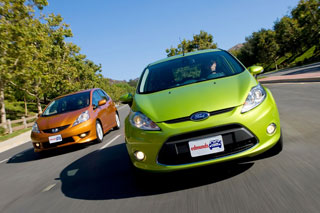Test Drive Honda Fit 2008 - 2010
Review of the new generation of compact car Honda Fit
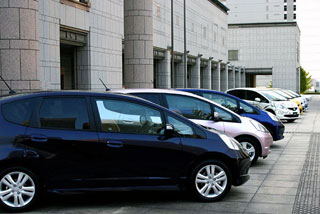 The difference between the old and new generation machine can be felt almost immediately
The difference between the old and new generation machine can be felt almost immediately It is believed that the former model of Honda Fit, despite all its advantages, still remained somewhat unfounded. And, nevertheless, the demand for her continued to continue and continues to remain quite high. What is the reason? I do not dare to insist, but, according to my conviction, her design played a considerable role here, which fell to taste both the male and female part of the drivers. With this scenario, it was hardly worth expecting that, working on a new generation machine, developers will be solved to significantly change its appearance. So it turned out.
But if there is a continuity of style, then in order to understand, and that in a new car really appeared new, it will be better to use the comparison method, right? So, let those readers who are familiar with the first generation Fit car will be formed, but I will continue to look back to compare everything that happened.
Immediately make a reservation: I managed to check both varieties of the car FIT of a new generation: a model with an engine in 1,300 cm3 and with a 1.5-liter motor. Moreover, in the title of the second model there is an RS abbreviation, which, as you understand, indicates that the car with some sports orientation.
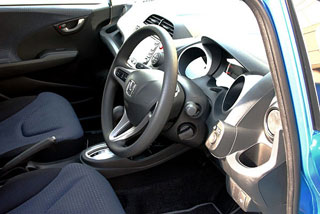 Of these two varieties in great demand, as you understand, a machine with a smaller cube engine will use, that is, with a cylinder volume of 1.3 liters. I've decided to start with her. Once at the wheel, I immediately began to get comfortable, confining for myself as a driver's chair and steering wheel. To achieve the desired positive result, in general, it was not difficult, since the steering column was regulated both by tilting and in length on the principle of the telescope. So, it is convenient to sit in your chair to the driver of great work, it is already talking about the class class.
Of these two varieties in great demand, as you understand, a machine with a smaller cube engine will use, that is, with a cylinder volume of 1.3 liters. I've decided to start with her. Once at the wheel, I immediately began to get comfortable, confining for myself as a driver's chair and steering wheel. To achieve the desired positive result, in general, it was not difficult, since the steering column was regulated both by tilting and in length on the principle of the telescope. So, it is convenient to sit in your chair to the driver of great work, it is already talking about the class class. Well, well, it's time to start the engine. There are no features in the operation for launching, as behind the wheel of the Honda Fit former generation. The engine begins to work, and so yes! I absolutely do not feel his vibration. I try to increase the load slightly, for which I turn on the air conditioner, waiting for it to somehow affect the behavior of the engine. It was not at all, the only thing I felt was the fan hum. As for the increased vibration laid in such cases, nothing again. That is, if it were not for the fan, I would have thought that the air conditioner was not working at all. Okay, I will take the transmission control lever (CVT stepless variator), I translate it to the position D, believing that now it is for sure, feel reinforced vibration. And once again I am mistaken!
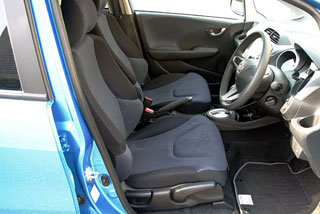 Yes, of course, the power transfer in the new car is carried out through the hydrotransformer, which was not previously, I know. But I also know that the idling vibration in the previous model was due to the shutdown of the clutch (front turn clutches). And in this regard, everything remains unchanged: while the machine is worth it, the coupling is in the off position, so as not to strain the transformer once again. And, nevertheless, the fact remains a fact: in the new car Fit the vibration of idling, and where it is like, probably, only designers are known!
Yes, of course, the power transfer in the new car is carried out through the hydrotransformer, which was not previously, I know. But I also know that the idling vibration in the previous model was due to the shutdown of the clutch (front turn clutches). And in this regard, everything remains unchanged: while the machine is worth it, the coupling is in the off position, so as not to strain the transformer once again. And, nevertheless, the fact remains a fact: in the new car Fit the vibration of idling, and where it is like, probably, only designers are known! True, it should be borne in mind that in the car there is a slope sensor, which under certain conditions does not give a coupling to turn off. In other words, if at the time of starting the movement the car stands horizontally or before the down (on the descent), then the power transmission turns out to be discontinued. But if she rows from the place, standing on the rise, then the wheels are enough immediately, and the car begins to crawl forward. I know this for sure because I checked myself.
It is known that some cars are arranged in such a way that it is only worth drivening a couple of hundred meters on it, and you already understand what its advantages, and in more than cons. So, I dare to say that the new Honda Fit is among such cars. Well, if so, then those drivers who had to ride a lot on the old car, enough, I think two minutes to feel than in practice the former Fit model is different from the new.
Why is it decided to abandon the I-DSI engine?
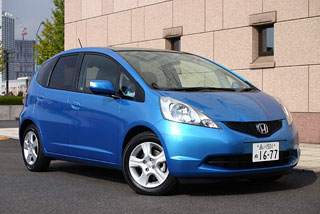 I will try to list the advantages of the car, which I immediately drew attention, and which give me grounds to say: the new fit, figuratively speaking, went beyond its class. So: the ability to quietly touch the engine, the smooth steering wheel, the exact reaction of the engine to the slightest change in the position of the gas pedal, light brake pedal, narrow (20 mm) front racks that almost do not interfere with the front review (here it should be noted that the front triangular windows should be noted here Square increased three times), well, and so on.
I will try to list the advantages of the car, which I immediately drew attention, and which give me grounds to say: the new fit, figuratively speaking, went beyond its class. So: the ability to quietly touch the engine, the smooth steering wheel, the exact reaction of the engine to the slightest change in the position of the gas pedal, light brake pedal, narrow (20 mm) front racks that almost do not interfere with the front review (here it should be noted that the front triangular windows should be noted here Square increased three times), well, and so on. The car's engine is surprising smoothly. Meanwhile, this is not the motor (type i-DSI), which was used in the former generation machines. No, when working on a new generation car from I-DSI, it was decided to refuse the I-VTEC system. What was the characterized engine type i-DSI? 2-valve input / output system + non-contact electron ignition system. Now the working volume of cylinders remained the same (1.3 liters), and the number of valves increased twice (4 on each cylinder). Until the motor keeps small speed, the i-VTEC system significantly limits the operation of one of the two intake valves. There is a powerful twist, due to which the fuel combustion is achieved. Along the way, it should be noted that the injector carries out the injection in two points, the volumes of injection correlate as 4: 6. But the speed of movement increases, and, accordingly, the engine load grows. In this case, both intake valves are included in the work, the gas distribution mechanism is translated into a forced mode, the injected fuel mixture is swollen, and as a result, a kind of compromise is established between the developed power and the amount of fuel incinerated.
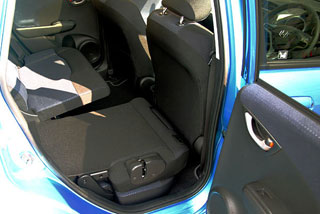 Why was it decided to refuse the i-DSI engine? After all, it is still unknown, as it were, the market fate of the first-generation FIT car, and he would have become so popular if he had not equipped with this engine the subject of legal pride of Honda engineers. And suddenly, after such a grand success, it turns out that without it is better! I asked the corresponding question to the company's representative, and that's what he answered me. Yes, he said, I must agree, in some sense, the I-DSI system provided a good service. However, when the car began to be exported abroad, it turned out that many do not share our delights about economy, and instead wanted the car to be more powerful. For our part, we could not ignore the opinion that, they say, in terms of the operational characteristics of the car there are spaces, so we decided: no, from now on, only 4 valves, and not less!.
Why was it decided to refuse the i-DSI engine? After all, it is still unknown, as it were, the market fate of the first-generation FIT car, and he would have become so popular if he had not equipped with this engine the subject of legal pride of Honda engineers. And suddenly, after such a grand success, it turns out that without it is better! I asked the corresponding question to the company's representative, and that's what he answered me. Yes, he said, I must agree, in some sense, the I-DSI system provided a good service. However, when the car began to be exported abroad, it turned out that many do not share our delights about economy, and instead wanted the car to be more powerful. For our part, we could not ignore the opinion that, they say, in terms of the operational characteristics of the car there are spaces, so we decided: no, from now on, only 4 valves, and not less!. Well, to say that the Fit car was powerful enough, I can't have something, that is. But to express dissatisfaction with this for me, at least it is strange. Especially since the improvement of the speed characteristics of the engine should, in theory, negatively affect the economy. Isn't it a reason for anxiety? I answered this question like this: Indeed, we had to do everything possible to get from the new engine Fit of the same fuel consumption that was before. To do this, we tried to reduce the inner friction losses, as well as enter a complex system of disconnecting a part of the inlet valves on small revolutions. And we ultimately managed and raise the engine capacity by 20 hp, and at the same time make the car more economical. It is likely to add to this that the greatest torque in terms of the working volume liter has already reached 10 kg-M, which largely simplified the operation of the engine, including at low speeds.
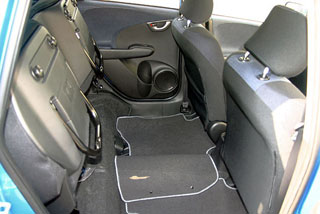 Meanwhile, to compare the car of the old and the new generation is still not entirely correct. And all because in the first case, the stepless variator was with a special starting clutch (a multi-disc clutch of a wet type, which was behind the belt transmission), then in the new Fit model, preference is given to the variator, which includes a torque converter.
Meanwhile, to compare the car of the old and the new generation is still not entirely correct. And all because in the first case, the stepless variator was with a special starting clutch (a multi-disc clutch of a wet type, which was behind the belt transmission), then in the new Fit model, preference is given to the variator, which includes a torque converter. The starting clutch, by the way, was a lot of advantages. And, nevertheless, she gave way to the hydrotransformer. Of course, it is impossible to deny the fact that it is easier to touch the transformer from the place when the car stands on the rise: the wheels immediately pick up the car, and it begins to chat forward. And the starting clutch was not enough immediately, and therefore there always existed the likelihood that while the driver would carry his leg from the brake on the gas, his car rolled back. But whether this argument outweighs this argument against all the arguments for the starting clutch, that is the question.
On a small and medium speed steering machine acting just wonderful
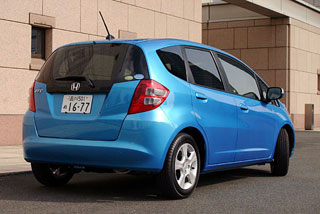 Let's see how the developers themselves determine the reason for the transition to the power transmission involving the hydrotransformer. Let me quote the words spoken by one of the company's representatives. We, he began, of course, knew that the starting clutch thing is good. However, a clear task was set to drive a large torque in the initial stage of movement. From here and change. See: Not only that at the time of starting the wheel began to pick up the car immediately, it was also possible to do with a small gear ratio in the main program, even despite the fact that the engine blocking with transmission is carried out at an earlier stage. And this in turn made it possible to reduce the internal losses of the stepless variator (the so-called losses on the belt transmission or Belt Loss). And in the end, first, the thrust improved, and secondly, it was possible to achieve fuel economy.
Let's see how the developers themselves determine the reason for the transition to the power transmission involving the hydrotransformer. Let me quote the words spoken by one of the company's representatives. We, he began, of course, knew that the starting clutch thing is good. However, a clear task was set to drive a large torque in the initial stage of movement. From here and change. See: Not only that at the time of starting the wheel began to pick up the car immediately, it was also possible to do with a small gear ratio in the main program, even despite the fact that the engine blocking with transmission is carried out at an earlier stage. And this in turn made it possible to reduce the internal losses of the stepless variator (the so-called losses on the belt transmission or Belt Loss). And in the end, first, the thrust improved, and secondly, it was possible to achieve fuel economy. The advantages of the hydrotransformer are not only that it allows you to vary the transmission of torque in a wider range at the initial stage of movement. In addition, he is able to quickly give the car an additional acceleration when the speed is already large enough. Consequently, in terms of practical driving, the value of the machine is only rising, and without a significant deterioration of economic indicators. And the fact that the engine blocking with the transmission occurs already on relatively small revolutions, not only reduces fuel consumption, but also aggravates the subjective sense of movement. Actually, all this is known for a long time, all this has already been tested on other models, so the variant with the torque converter together the starting coupling can be considered quite justified.
If, driving a new Honda Fit model, start moving slowly and carefully, following the tachometer reading, you can make sure that the blocking is turned on when the engine speed reaches the value of approximately 1,200 rpm. It happens like this: the arrow stands against the mark 900, after which there is a slight increase in the speed of movement, and, accordingly, the revolutions increases. Moreover, the transition is performed clean and imperceptibly, unless, of course, do not specifically look.
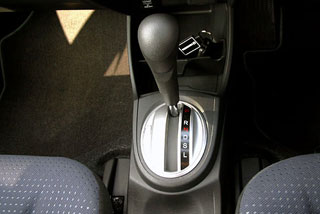 When the circumstances require to be touched from a place on a full gas, a set of revolutions occurs with greater intensity than the FIT car for the previous generation, so that the time for primary overclocking is also required. Of course, it would be strange if it were not, given the fact that the new machine has a more powerful motor and in its power transmission a hydrotransformer is involved. I just want to emphasize: the new fit runs more than his predecessor.
When the circumstances require to be touched from a place on a full gas, a set of revolutions occurs with greater intensity than the FIT car for the previous generation, so that the time for primary overclocking is also required. Of course, it would be strange if it were not, given the fact that the new machine has a more powerful motor and in its power transmission a hydrotransformer is involved. I just want to emphasize: the new fit runs more than his predecessor. However, an energetic acting drive is not all. By and large, the price is the price of such an energy, if the car does not have a steering steering. In this car, everything is just, on the contrary: on a small and medium speed, the car is so sensitive to the steering wheel, so much ready to perform any of his team that I will not seek against the truth, if I say: among the class CD cars, you will have infrequently. I will say more: In this regard, the new fit will not give way to many and many models class above. I was especially struck by how it was easy to hold the car on a straight line, and also pleased with his amazing obedience when at high speed it is necessary to go into the next row. Neither in the first nor in the second case did not require any excessive efforts: I acted in the literal sense with the tips of my fingers, and this was enough. Thus, the new car was not only more than more. It also does not require that of his driver too much cost of its energy, that is the paradox. In addition, it should be noted that confidence, then calm that does not leave you all the time while you are driving. And this is directly affecting the safety of movement. So personally, I have all my hands for a new model!
After all, what is good: despite its high speed potential, the car, whatever the type of road cover, has always demonstrated enviable stability, so sometimes the confidence was born that the car truly is really able to realize any of my ideas on the road. The suspension seemed to me at all as tough as in the car of the previous generation. She acted calmly and measured, besides, providing reliable contact of the wheels with the surface of the road.
It should be noted that the front wheels of the car are installed in such a way that the axis of their turn has a very decent corner of the longitudinal tilt (Caster). Such a tilt allows the wheels to successfully deal with blows due to road irregularities. Plus, in the rear suspension, it was decided to use longitudinal levers of increased length (before the length was 396 mm, now it was 435 mm). It is clear that in this case the amplitude of oscillations decreased, which made it possible to use less rigid springs in the suspension. I will call a number of conditions that, in one way or another, positively influenced both on the stability of the machine, and on its ability to move in a straight line, not fishing around. First, this increase by 50 mm of the wheelbase, secondly, this increase by 20 mm of its total width, which is accompanied by an increase in the rutting of both the front (35 mm) and the rear (30 mm) wheels.
If you look medium fuel consumption, it turns out that the fuel is spent with more benefit
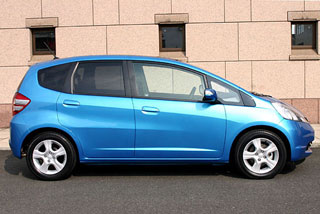 Road noise in the cabin of a new car managed to greatly muffle. As the representative of the company told, the noise level depends on the speed of movement, and it happens that it does not exceed 2 decibels. If this is true, I imagine what it was worth it. Moreover, as it turned out, modern sound-absorbing and soundproofing materials is not all. To achieve silence in the cabin, explained the representative, the developers had to think how to increase the rigidity of the body without increasing its mass. Plus, it was necessary to make changes to the rear shock absorbers mounting brackets, as well as strengthen the place of attachment of the pendant parts to the body. And yet: 30 percent increased the size of the hinders of the rear longitudinal levers to the body, as a result of which the rear suspension is changed in the direction of increasing, adequately adequacy of the levers. That's what measures had to be taken to not give road noises to penetrate into the salon.
Road noise in the cabin of a new car managed to greatly muffle. As the representative of the company told, the noise level depends on the speed of movement, and it happens that it does not exceed 2 decibels. If this is true, I imagine what it was worth it. Moreover, as it turned out, modern sound-absorbing and soundproofing materials is not all. To achieve silence in the cabin, explained the representative, the developers had to think how to increase the rigidity of the body without increasing its mass. Plus, it was necessary to make changes to the rear shock absorbers mounting brackets, as well as strengthen the place of attachment of the pendant parts to the body. And yet: 30 percent increased the size of the hinders of the rear longitudinal levers to the body, as a result of which the rear suspension is changed in the direction of increasing, adequately adequacy of the levers. That's what measures had to be taken to not give road noises to penetrate into the salon. As already mentioned, in the FIT car of the new generation almost no engine vibration, and on the other hand, the suspension acts quite satisfactorily. And at the same time I can not help but notice that when at a certain velocity the wheels are stumbled into defects in the road surface, sometimes you feel some easy return. So, for example, it happened when I followed with a speed of 40 ~ 50 km / h, and under the wheels there was a traffic junction, which, it seems not so big, but the machine's reaction was too noticeable. I believe that this happened due to the fact that the engine is fixed on the body is not hard enough. But on the other hand, such soft pillows were chosen specifically in order to combat vibration, this is what focus! Well, well, while the car without a run, it still walked. But then, apparently, this phenomenon will begin to give itself to know more and more persistently, isn't it? That's really, not one thing, so theiff, and that of these two angry, the designers, apparently, is still to be solved. By the way, the new Honda Fit RS series with a 1.5-liter engine is less noticeable, I suppose because the suspension is slightly tougher there.
On the highway in order to provide a car speed of 100 km / hour Engine keeps approximately 2,000 revolutions per minute. Meanwhile, the first-generation FIT car in similar cases is rotating about 200 rpm faster. Already one indicates that, in terms of the new car, the new car is all right. But that's not all. If you put the car in overclocking on the descent, following how the speed and speed of the engine relate, it can be noted that the turns fall very rapidly, disproportionate speed growth. In short, it is clear that the power transmission is configured so that at any convenient case to give the engine to switch to reduced turns. Overly to say, how much such a setting has a positive effect on the average fuel consumption.
By the way, to say, switching the information display, located in front of the driver, can be displayed on the scoreboard information about the total amount of fuel burned. Usually, its instant consumption is visualized on the scoreboard. So, perhaps someone such informational support will save a couple of fuel liters, and it will become good. But the main thing you get behind the wheel, you start moving, and immediately understand: yes, the car is really with good economic indicators and ride it profitable. And from this, too, agree, can become joyful in the soul.
Is it possible to assume that all the shortcomings noticed before being eliminated?
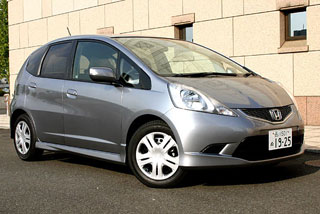 If you assess the manageability of the new Fit machine, then on it, I note, influenced and overlaid suspension, well, and, of course, the modified geometry of the installation of the wheels. As a result of the changed changes in the quality of the car when driving on a turn, changed significantly for the better. In particular, when you begin to turn, there is no feeling that first, however, only the front wheels are turning on themselves, and only then, reluctant, follows the body. No, everything is perceived otherwise: the front wheels are completely naturally pressed on the road, and the body of the car on the inertia goes on, it turns into the wheels, it turns out, and the car, thus changes the direction of movement. And everything happens in a good pace, verified and accurately. You know, I drove through the urban streets, then drove out the city, then went to the highway, and everywhere I felt calm. As a result, I spent behind the wheel for a long time, but almost no fatigue.
If you assess the manageability of the new Fit machine, then on it, I note, influenced and overlaid suspension, well, and, of course, the modified geometry of the installation of the wheels. As a result of the changed changes in the quality of the car when driving on a turn, changed significantly for the better. In particular, when you begin to turn, there is no feeling that first, however, only the front wheels are turning on themselves, and only then, reluctant, follows the body. No, everything is perceived otherwise: the front wheels are completely naturally pressed on the road, and the body of the car on the inertia goes on, it turns into the wheels, it turns out, and the car, thus changes the direction of movement. And everything happens in a good pace, verified and accurately. You know, I drove through the urban streets, then drove out the city, then went to the highway, and everywhere I felt calm. As a result, I spent behind the wheel for a long time, but almost no fatigue. The operation of the brake system also did not cause me special complaints. In particular, if I needed to slow down to slow down, I pressed the pedal with force on the pedal, and everything, high speed anything happened. However, as everyone understands, when you are one of the participants in the movement, it is advisable to exist gradually. And that's what I noticed: When you start easily putting on the pedal, the wheels, as it should be, is slowed down. But if then, waiting, pick up a little bit, the inhibition strength increases not smoothly, but unexpectedly sharply, and everything, the speed is quenched. And this thoughts in connection with this I had. Suppose there is a private problem, for example, inconsistency in the operation of the brakes. Of course, you can take and enlarge the work move of the pedal, and then, for sure, the brakes will become easier to manage, and for a while, the question from the agenda will be removed. But you can do otherwise: do the brake system as a whole, you will see, and it will be possible to make some fundamental changes in it. It is easier, of course, go first, however, it seems to me that if you do not think about the general, then there is little in particular.
 In conclusion I would like to stop at what. In the Honda Fit car of the first generation, I, (and not only I), drew attention to a number of moments over which, from my point of view, should work. So, I decided to understand whether all these shortcomings were eliminated, or not. I opened my records, analyzed them, and allocated the main weaknesses of the former generation machine.
In conclusion I would like to stop at what. In the Honda Fit car of the first generation, I, (and not only I), drew attention to a number of moments over which, from my point of view, should work. So, I decided to understand whether all these shortcomings were eliminated, or not. I opened my records, analyzed them, and allocated the main weaknesses of the former generation machine. I list: an amplifier of the steering drive, the disadvantages of which were due mainly to it, so to speak, electrical nature (EPS or Electric Power Steering). Next, the brake pedal was poorly felt. What else? The stiffness of the suspension, then, not quickly fast transmission reaction at the start. Further, a large speed drop before stopping the machine that penetrates the noise of the road, a high fuel consumption on a cold engine. And, finally, the unpleasant sound of the splashing fuel, came from the benzobacing side whenever the car slowed down (of course, we are talking about cases when the tank turned out to be semi-empty).
I'll start with the steering. I can say that in this regard everything was resolved the most favorable way. What did I not like the former amplifier? First, he acted rudely, annoyingly reminding his, so to speak, mediated between me and controlled wheels. But I would only like it! It happened so that the car goes in a straight line, you, focusing on her front, you start acting with a steering wheel to get down to the side, and in front of the car leaves what you planned. Ultimately, you managed to choose the root of the right position, but you know: call it with a turn, performed by a slight movement of the steering wheel, was no longer possible. Naturally, the driver had to constantly be alert, so that, God forbid, do not pick up too much aside. So, I can confirm: now all these problems stayed behind.
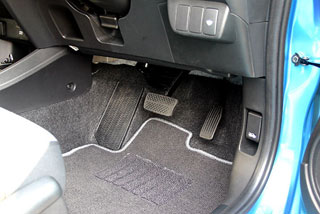 If you believe the company's representative, it was necessary to even connect specialists from the company's research center. What is ultimately decided to do? No, no, I warned the representative in advance, until the installation of an electric motor that would not have collective brushes, it did not come. To combat inertia phenomena, we chose a different path. First of all, we increased the power of the old electric motor from 40 to 60 amps, revised the transmission steering coefficient (18.3 was 17.7), the caster of the front wheels was changed (it was 2.16, 3,18 degrees were 3.16) and, accordingly, increased the trail from 5, 4 mm to 18.2 mm. Well, a lot has done, but the result is also evident.
If you believe the company's representative, it was necessary to even connect specialists from the company's research center. What is ultimately decided to do? No, no, I warned the representative in advance, until the installation of an electric motor that would not have collective brushes, it did not come. To combat inertia phenomena, we chose a different path. First of all, we increased the power of the old electric motor from 40 to 60 amps, revised the transmission steering coefficient (18.3 was 17.7), the caster of the front wheels was changed (it was 2.16, 3,18 degrees were 3.16) and, accordingly, increased the trail from 5, 4 mm to 18.2 mm. Well, a lot has done, but the result is also evident. Now, with regard to the brake pedal, which was previously felt. It was stated that engineers had to be imprisoned here, but ultimately, they increased the shoulder pedals, and also reduced the diameter of the piston of the main brake cylinder. In my opinion, a representative of the company was concluded, now the subjective sense of controllability of the brakes has become quite different, at least, while there are no other changes here we are planning. Well, some improvement, I really felt, although, honestly, it is still far to perfection.
Almost all the disadvantages seen before, and the driving quality of the car is simply outstanding
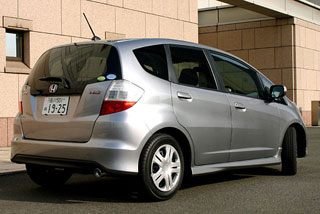 Once again I remind you of which specifically the changes were made to the running system when developing a new generation Fit car. So, the wheel's track is increased, the length of the suspension levers and their shoulder changed. This led to the fact that the suspension began to act with greater smoothness. It should also be mentioned about increasing the size of the sleeves, by which the suspension levers are attached to the body, as well as changing the geometry of the installation of the wheels themselves. Well, we must not forget that the so-called road noises have become less audible in the cabin, but not only the work on the improvement of the suspension elements, but also increased compared to the first-generation car, the body rigidity compared to the first-generation machine. And I can confirm: the wheel is well felt, all these events have not passed for a new car for nothing.
Once again I remind you of which specifically the changes were made to the running system when developing a new generation Fit car. So, the wheel's track is increased, the length of the suspension levers and their shoulder changed. This led to the fact that the suspension began to act with greater smoothness. It should also be mentioned about increasing the size of the sleeves, by which the suspension levers are attached to the body, as well as changing the geometry of the installation of the wheels themselves. Well, we must not forget that the so-called road noises have become less audible in the cabin, but not only the work on the improvement of the suspension elements, but also increased compared to the first-generation car, the body rigidity compared to the first-generation machine. And I can confirm: the wheel is well felt, all these events have not passed for a new car for nothing. The next point of my list of seen deficiencies in the old wheel of the wheel was too slowly picked up by the transmission, and therefore was a high probability of rollback of the machine back at the beginning of the movement on the rise. As it has already been said to correct the situation, in the new car it was decided to abandon the starting clutch in favor of the hydrotransformer, as well as make a special sensor control system control system. These measures, according to the representative of the company, made it possible to transition to the mode of movement not by a pre-programmed scheme, but what is called, on the setting. On the other hand, he continued, due to such significant changes made to the power transmission, no one will no longer confuse our fit with other models of this class, right?.
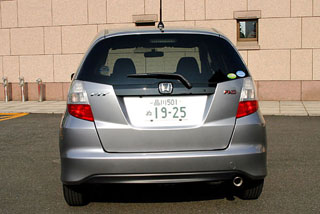 Another disadvantage, which was noted in the FIT car earlier, a large speed difference that took place immediately before stopping. On this occasion, the company's representative was as follows: the fact that a hydrotransformer is involved in the power transmission, does not remove the task of maximum fuel economy from the agenda. That is why when the speed is quenched, it is important that the cut-off of the fuel las down as long as possible until the moment preceding the full stop. So in the new model, the proceedable transmission management program is designed in such a way that the fuel cut off up to the smallest engine speed. Naturally, at such moments, the motor acts as a rather powerful brake, therefore, when the fuel supply is resumed, and flashes are resumed, it cannot but lead to a jerk. But we did so that the throttle revealed at the right moment (the benefit that the electronics operates everyone), so in the end everything goes more or less smoothly. And this is true: where the jerk had previously followed, in the new car, nothing like this: it stops smoothly, as if nothing had happened.
Another disadvantage, which was noted in the FIT car earlier, a large speed difference that took place immediately before stopping. On this occasion, the company's representative was as follows: the fact that a hydrotransformer is involved in the power transmission, does not remove the task of maximum fuel economy from the agenda. That is why when the speed is quenched, it is important that the cut-off of the fuel las down as long as possible until the moment preceding the full stop. So in the new model, the proceedable transmission management program is designed in such a way that the fuel cut off up to the smallest engine speed. Naturally, at such moments, the motor acts as a rather powerful brake, therefore, when the fuel supply is resumed, and flashes are resumed, it cannot but lead to a jerk. But we did so that the throttle revealed at the right moment (the benefit that the electronics operates everyone), so in the end everything goes more or less smoothly. And this is true: where the jerk had previously followed, in the new car, nothing like this: it stops smoothly, as if nothing had happened. 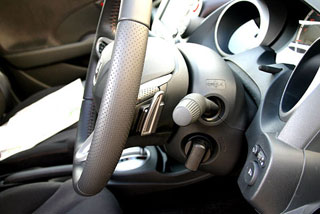 The next item is a list of flaws of the old car increased fuel consumption on a cold engine. Yes, it really was so, I noticed a company representative about this, and not only that the money was flying to the wind, it also suffers from the ecology, since it is clear that if the fuel burns not completely, it means in the exhaust gas full-fully harmful impurities. And the catalyst is not able to do anything with it, since it is still cold. Well, we decided to install the first stage catalyst right at the output, and even so that the heat does not disappear in vain, the exhaust collector itself is decided directly on the head of the cylinder block. Well, such a solution seems quite reasonable: it is not enough that the exhaust gas is faster, the engine warming process takes less time. And if so, then in general, the average fuel consumption is reduced, even if instant consumption continues to be increased.
The next item is a list of flaws of the old car increased fuel consumption on a cold engine. Yes, it really was so, I noticed a company representative about this, and not only that the money was flying to the wind, it also suffers from the ecology, since it is clear that if the fuel burns not completely, it means in the exhaust gas full-fully harmful impurities. And the catalyst is not able to do anything with it, since it is still cold. Well, we decided to install the first stage catalyst right at the output, and even so that the heat does not disappear in vain, the exhaust collector itself is decided directly on the head of the cylinder block. Well, such a solution seems quite reasonable: it is not enough that the exhaust gas is faster, the engine warming process takes less time. And if so, then in general, the average fuel consumption is reduced, even if instant consumption continues to be increased. And, finally, the last point is the sound of the pouring from the wall to the wall of the fuel in a semi-empty benzobank. On this occasion, the following was stated: the tank is made of plastic mass, so placing special partitions inward so that they can be broken by the wave. Therefore, as we tried, we are not able to fully cope with this sound. Well, well, it remains only to calm yourself because the phenomenon occurs only from time to time when the tank is completely empty. But if you do not bring it to such a state, and on time to refuel, then no negative. And hereinafter, I think the designers will come up with something, for example, change the shape of the tank.
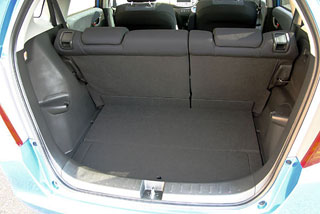
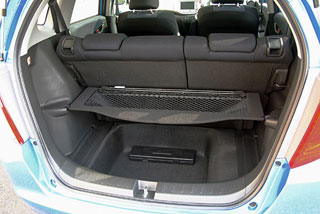
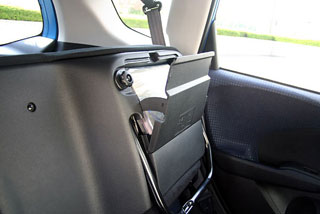
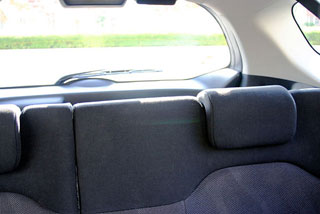
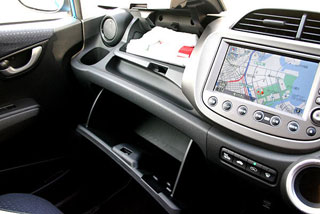
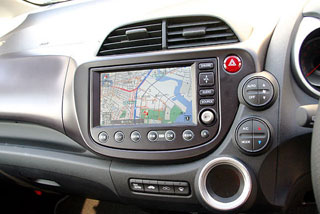
A source: AGN.

